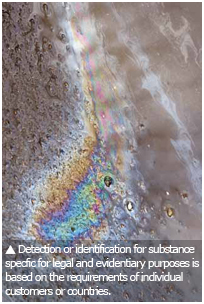Data Security
Gathering useful information on suspicious substances with a detector is only half the task. Once the substance is confirmed, the information must be shared with relevant bodies for correct identification and a further course of action. “There is a trend of integrating data from a number of detectors or reports in a single user interface to allow for optimal situational awareness for the proprietor of a building or first responder,” Gaasbeek said. “This trend is mostly visible in the field of integrated security systems for critical infrastructure and in first responder software, where models are used in combination with a geographic information systems environment for optimal situational awareness.”
Sometimes data that is relevant to CBRN response is information that is public knowledge, or is easily known. Once concentrated, integrated and correlated with other information it becomes confidential and is only shared within a designated network. “Data security is vital for agencies in order to effect a measured and coordinated response to CBRN incidents. To counter leaks, encryption and compartmentalization are common tactics,” Johnson said. Serial communication is also widely used when transferring data.
So far no database connectivity on a national or international level is known, although cooperation with individual government bodies exists. “In the U.S., organizations such as the Domestic Nuclear Detection Office and Department of Energy often have agreements in place to provide reach back services for local, state and federal agencies,” Koga said.
Upgrades, Standards, Testing and Training
 Technology upgrades are determined by the nature of what is offered by manufacturers. “For newly introduced technologies, roughly 5 to 10 percent of customers are willing to invest, while the rest of a given customer set relies on older technology, taking a wait-and-see stance to see how well the new technologies are accepted," Johnson said. "Exceptions are when a new technology addresses a long-standing problem, such as aroma sensing technology for cargo screening, and/or when the technology is mandated by authorities.” However, upgrades normally involve disposable or reusable kits with a fixed lifetime and software only; hardware upgrades are uncommon, as customers usually decide on the latest product when purchasing hardware. Some industry experts find military agencies are the predominant buyers of the latest hardware models.
Technology upgrades are determined by the nature of what is offered by manufacturers. “For newly introduced technologies, roughly 5 to 10 percent of customers are willing to invest, while the rest of a given customer set relies on older technology, taking a wait-and-see stance to see how well the new technologies are accepted," Johnson said. "Exceptions are when a new technology addresses a long-standing problem, such as aroma sensing technology for cargo screening, and/or when the technology is mandated by authorities.” However, upgrades normally involve disposable or reusable kits with a fixed lifetime and software only; hardware upgrades are uncommon, as customers usually decide on the latest product when purchasing hardware. Some industry experts find military agencies are the predominant buyers of the latest hardware models.
There are currently no established standards for CBRN detectors. “In Europe, the EU CREATIF, a network of testing facilities for CBRN detection equipment, is trying to develop European testing standards,” Rothbacher said.
NATO also offers basic performance and environmental standards for detector testing. These standards are often developed for the military field, and might not be suitable for civilian environments, where threat levels are perceived differently. “When new testing standards are developed based on terrorist threat levels, the focus will probably be on higher sensitivity and higher accuracy (low false-positive and low false-negative readings),” Gaasbeek said. “It is unlikely that these new standards will develop in the short-term, and also improbable to shift toward lowering the threat levels, since the worst-case scenario in the military environment is still present — a full-scale attack.”